Introduction
This document describes how to implement the change(s) specified for Circuit Switch Fall Back (CSFB) activation in order to allow the voice and Short Messaging Service (SMS) with Mobile Switching Center (MSC)/Visitor Location Registry (VLR) over a subscriber group (SG) interface. The SG interface is between Mobility Management Entity (MME) in the Evolved Packet System (EPS) and the VLR, in order to allow location management coordination and in order to relay certain messages related to circuit switched services over the EPS system.
This is implemented on a MME deployed on Cisco Aggregated Service Router (ASR) 5x00 series (ASR5x00).
Prerequisites
Requirements
Ensure that you have Show Support Details (SSDs), bulkstat files, syslog files and any additional CLI output as required for the identified ASR5x00 nodes.
Components Used
This document is not restricted to specific software and hardware versions.
The information in this document was created from the devices in a specific lab environment. All of the devices used in this document started with a cleared (default) configuration. If your network is live, make sure that you understand the potential impact of any command.
Background Information
What is CSFB?
CSFB allows 3G/4G capable User Equipment (UE) to fallback to the 3G network for circuit switch functions, supports SMS, and voice calls.
References
- 3rd Generation Partnership Project (3GPP) Technical Specfications (TS) 23.272: Circuit Switch (CS) fallback in EPS
- 3GPP TS 29.118: SG interface specification
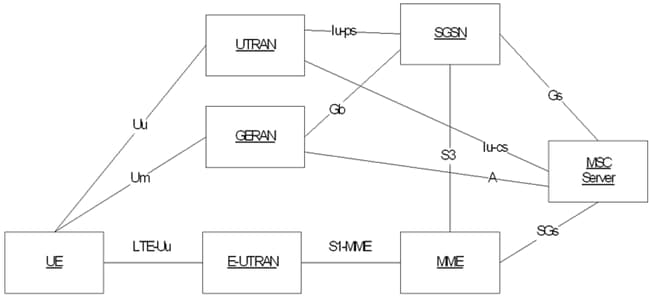
This diagram is based upon SGs that use Steam Control Tranmission Protocol (SCTP) for transport:
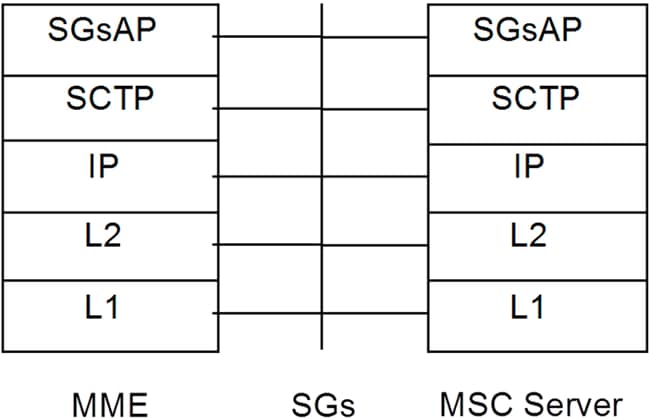
Mobile Originating Call (PS Handover)
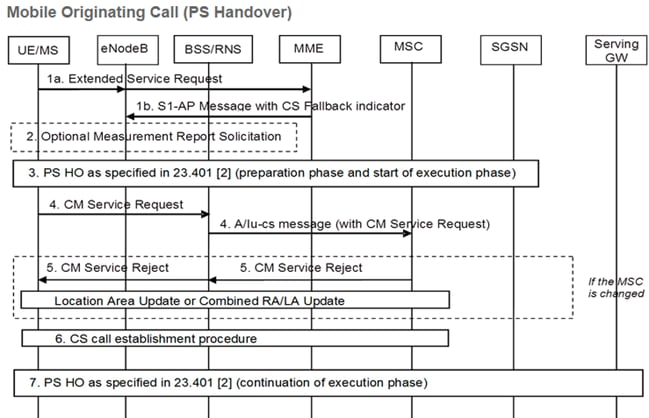
Mobile Originating Call (PS Suspension)
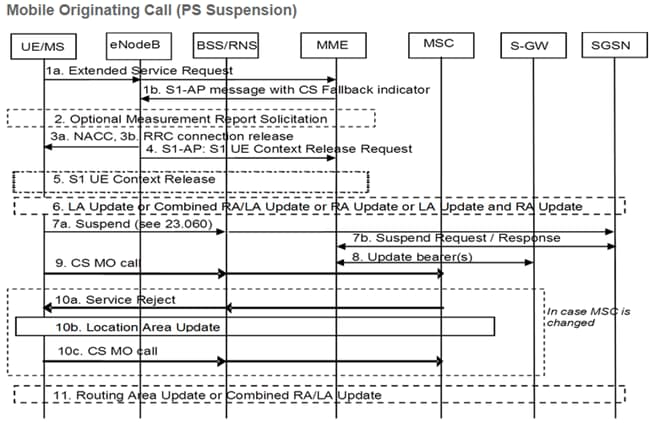
Mobile Terminating Call (Idle Mode)
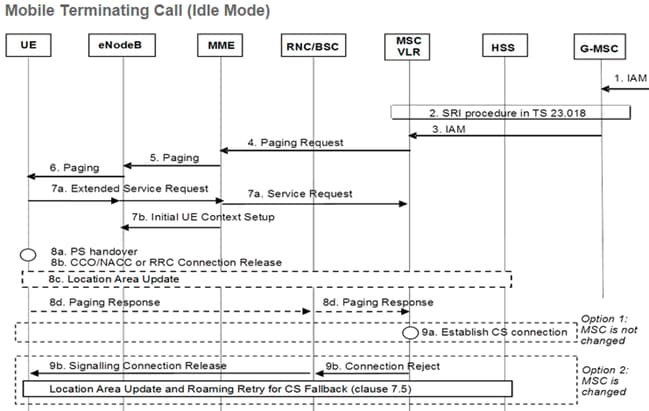
Mobile Terminating Call (PS Handover)
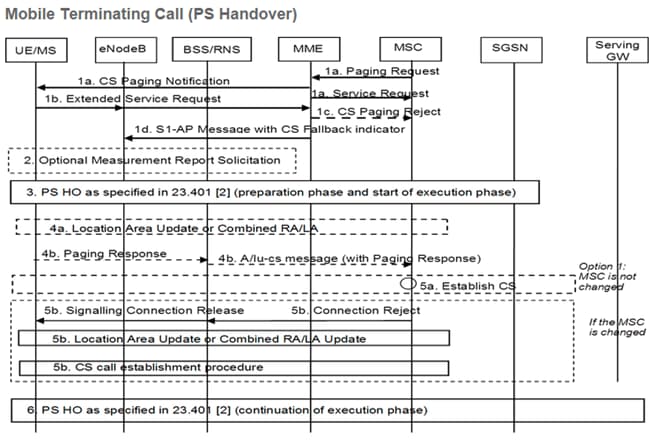
3G-to-4G Reversion
- UE Decides
- If Packet Switch (PS) Hand-over (HO) occurred, reversion is normal 3G-to-4G HO
- If PS Suspension occurred, network recovers suspended bearers for UE that returns
Mobile Call (PS Resumption)
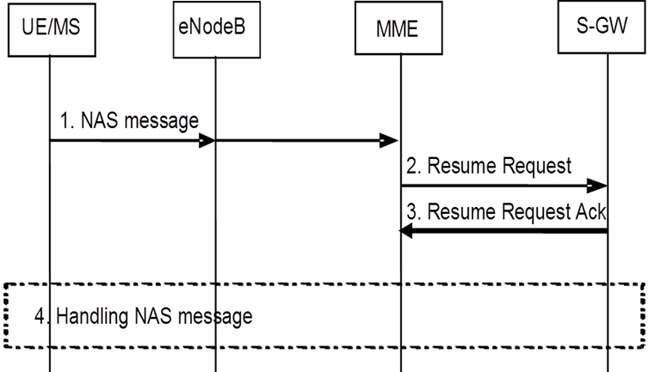
Configure
Note: Use the Command Lookup Tool (registered customers only) in order to obtain more information on the commands used in this section.
Pre-Activation Health Check
Collect the output of these commands:
show configuration
show crash list
show alarm all
show snmp trap history
show configuration errors
show logs
show card table
show card hardware
show subscribers summary
show leds all
show port utilization table
show linecard table
show card mapping
show session progress
show threshold
show ntp associations
show cpu table
show ntp status
show system uptime
show clock
show license information
show task resource
show ip interface summary
Repeat below steps over all context
Context <context_name>
show ip interface summary
show ip route
show egtp-service all
show egtpc statistics
show session disconnect-reasons
show mme-service all
show mme-service enode-association all
show hss-peer-service service all
show diameter peers full
show sgs-service all
show sgs-service vlr-status full
Logs checkpoint
clear snmp trap history
Pre-Activation Procedure
- Save the current configuration to the Flash drive for backup.
- Use the Naming conventions as per Operator Nomenclature:
[local] #save configuration /flash/Config_Date_before_activity.cfg -r -no
- Enter the show support details command in order to see the details of the chassis:
[local] #show support details
- Enter the show boot command in order to confirm the existing boot order:
[local] #show boot
boot system priority 7 \
image /flash/production.37140.st40.bin \
config /flash/QGLC-final-25-08-11.cfg
boot system priority 8 \
image /flash/production.37140.st40.bin \
config /flash/config_g101.cfg
boot system priority 9 \
image /flash/production.34838.st40.bin \
config /flash/config_g101.cfg
boot system priority 10 \
image /flash/st40.bin \
config /flash/system.cfg
- Enter the show license information command in order to confirm the installed CSFB license on the chassis:
[local] #show license information
Key Information (installed key):
Comment MME/SGSN 1 SO:50931561,51138669
Device 1 Model: "VICF4GB"
Serial Number: "VICF4GB00000B7B"
Device 2 Model: "VICF4GB"
Serial Number: "VICF4GB00000C0D"
Issued Monday November 28 12:05:59 EST 2014
Issued By Cisco Systems
Key Number 48086
Enabled Features:
Feature Applicable Part Numbers
---------------------------- -----------------------------
IPv4 Routing Protocols [ none ]
IPv6 [ N/A / N/A ]
Lawful Intercept [ ASR5K-00-CSXXLI ]
RADIUS AAA Server Groups [ ASR5K-00-CSXXAAA ]
SGSN Software License [ ASR5K-00-SN10SESS / ASR5K-00-SN01SESS ]
MME license: [ ASR5K-00-ME01BASE / ASR5K-00-ME10LIC ]
+ Session Recovery [ ASR5K-00-PN01REC / ASR5K-00-HA01REC
ASR5K-00-00000000 / ASR5K-00-GN01REC
ASR5K-00-SN01REC / ASR5K-00-AN01REC
ASR5K-00-IS10PXY / ASR5K-00-IS01PXY
ASR5K-00-HWXXSREC / ASR5K-00-PW01REC
ASR5K-05-PHXXSREC / ASR5K-00-SY01R-K9
ASR5K-00-IG01REC / ASR5K-00-PC10SR
ASR5K-00-EG01SR / ASR5K-00-FY01SR
ASR5K-00-CS01LASR / ASR5K-00-FY01USR ]
+ Enhanced Lawful Intercept [ ASR5K-00-CS01ELI / ASR5K-00-CS10ELI ]
APN Aliasing [ ASR5K-00-SNXXALES ]
Circuit Switched Fallback [ ASR5K-00-CS01CSFB ]
Always On Licensing [ ASR5K-00-GNXXAOL ]
Session Limits:
Sessions Session Type
-------- -----------------------
610000 MME license
CARD License Counts:
[none]
Status:
Device 1 Matches card 8 flash
Device 2 Matches card 9 flash
License Status Good (Redundant)
CSFB Activation Procedure
- Configure the SG interface with the given IP address.
- Configure the SG service with the Stream Control Transmission Protocol (SCTP) port number, Tracking Area Code (TAC) to Location Area Code (LAC) mapping, pool area, and so forth.
- Bind the interface IP address to the SG service and associate a SCTP template if any:
[local]#config
[local](config)#context mme
[mme](config-ctx)#interface sgs
[mme](config-if-eth)#ip address xxx.xxx.xxx.xxx 255.255.255.xxx
[mme](config-if-eth)#exit
[mme](config-ctx)#sgs-service sgs_svc
[mme](config-sgs-service)#sctp port xxxx
[mme](config-sgs-service)#tac-to-lac-mapping any-tac map-to lac xxx
[mme](config-sgs-service)#vlr VLR1 ipv4 xxx.xxx.xxx.xxx
ipv4-address xxx.xxx.xxx.xxx port xxx
[mme](config-sgs-service)#pool-area east_nodes
[mme](config-sgs-pool-area)#lac xxx
[mme](config-sgs-pool-area)#hash-value non-configured-values use-vlr VLR1
[mme](config-sgs-pool-area)#exit
[mme](config-sgs-service)#bind ipv4 xxx.xxx.xxx.xxx
[mme](config-sgs-service)#associate sctp-param-template sgs_svc
[mme](config-sgs-service)#exit
- Associate the SG service name with MME service:
[mme](config-ctx)#mme-service mme_svc
[mme](config-mme-service)#associate sgs-service sgs_svc context mme
[mme](config-mme -service)#end
- Configure the Virtual LAN (VLAN) for the SG interface and bind to the respective context name:
[local]#config
[local](config)#port ethernet 17/1
[local](config-port-17/1)#vlan 181
[local](config-port-17/1-vlan-181)#no shutdown
[local](config-port-17/1-vlan-181)#bind interface sgs mme
[local](config-port-17/1-vlan-181)#end
Post-Activation Procedure
- Save the current configuration to the Flash drive for backup.
- Use the Naming conventions as per Operator Nomenclature:
[local] #save configuration /flash/Config_Date_After_activity.cfg -r -no
- Enter the show support details command in order to display the details of the chassis:
[local] #show support details
- Enter these commands in order to capture the activity statistics:
local]#show sgs-service all
[local]#show sgs-service vlr-status full
[local]#show sgs-service statistics all
[local]#show crash list
[local]#show alarm all
[local]#show snmp trap history
[local]#show configuration errors
- Enter these commands in order to capture the hardware statistics:
[local]#show task resource
[local]#show alarm outstanding
[local]#show cpu table
[local]#show port utilization table
[local]#show npu utilization table
[local]#show snmp trap
[local]#show card table all
- Enter these commands in order to capture the service status:
[local]#show mme-service all
[local]#show mme-service db record all
[local]#show mme-service enode-association all
[local]#show mme-service id summary
[local]#show mme-service session full
[local]#show session disconnect-reasons
[local]#show session progress
[local]#show mme-service statistics
[local]#show hss-peer-service service all
[local]#show subscriber mme-only summary
[local]#show subscriber mme-only data-rate
[local]#show hss-peer-service statistics all
[local]#show egtp-service all
[local]#show egtpc statistics
[local]#show diameter peers full
[local]#show sgs-service all
[local]#show sgs-service vlr-status full
Note: This output is captured with reference to Long Term Evolution (LTE) network. If the chassis includes other services, then include related statistics.
Rollback Process
In the event that the new configuration or changes do not work properly or other problems arise, revert to the previous configuration:
- Enter these commands in order to remove the SG interface and SG service from the configured context:
[local]#config
[local](config)#context mme
[mme](config-ctx)#no interface sgs
[mme](config-if-eth)#exit
[mme](config-ctx)#no sgs-service sgs_svc
- Enter these commands in order to remove the SG service association from MME service:
[mme](config-ctx)#mme-service mme_svc
[mme](config-mme-service)#no associate sgs-service
[mme](config-mme -service)#end
- Enter these commands in order to remove the VLAN configured for the SG interface:
[local]#config
[local](config)#port ethernet 17/1
[local](config-port-17/1)#no vlan 181
[local](config-port-17/1)#end
Statistics/Status
show sgs-service service-name <name>
show sgs-service statistics
show sgs-service vlr-status { full }
show mme-service session full
Verify
There is currently no verification procedure available for this configuration.
Troubleshoot
There is currently no specific troubleshooting information available for this configuration.








 Feedback
Feedback